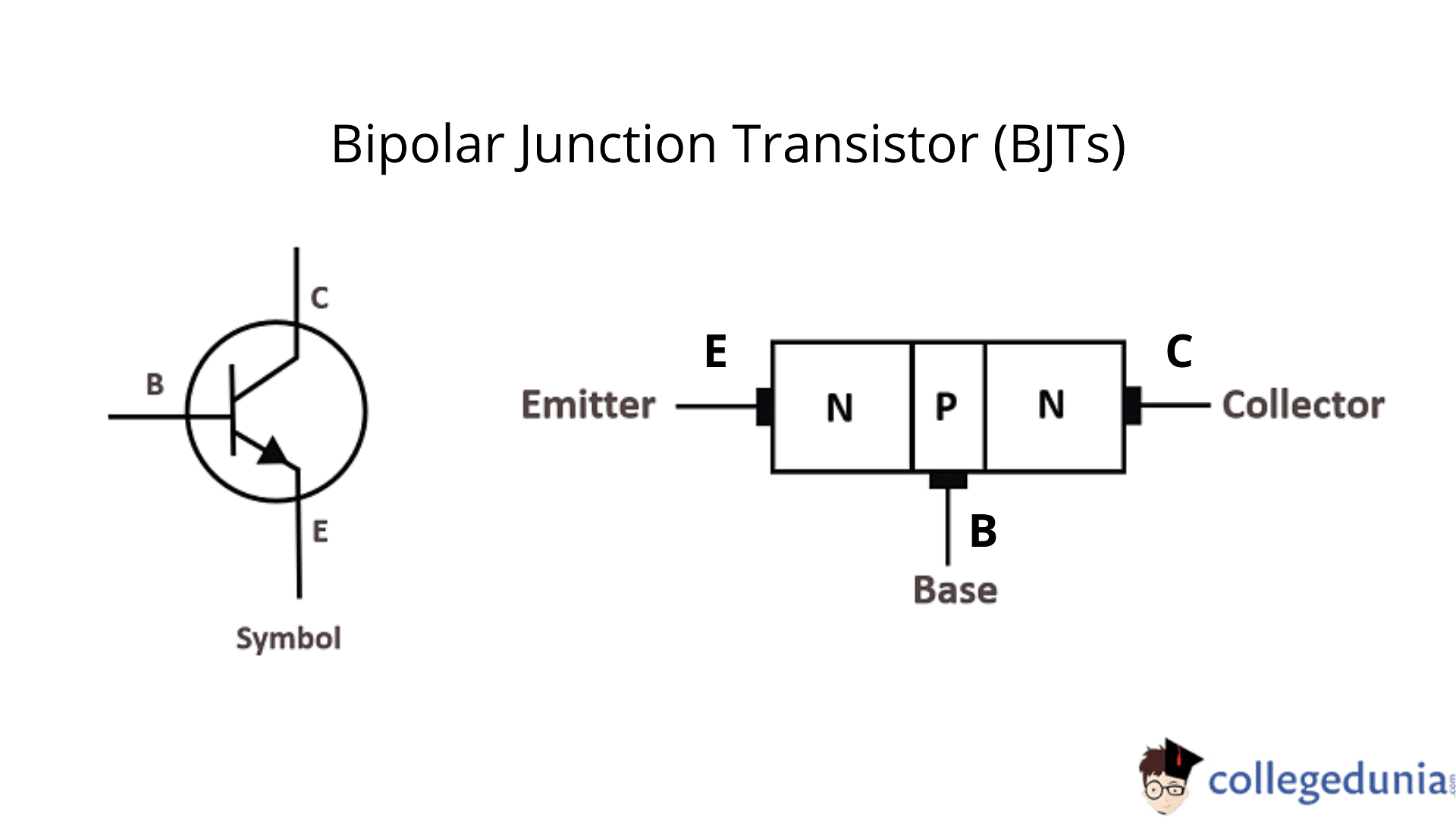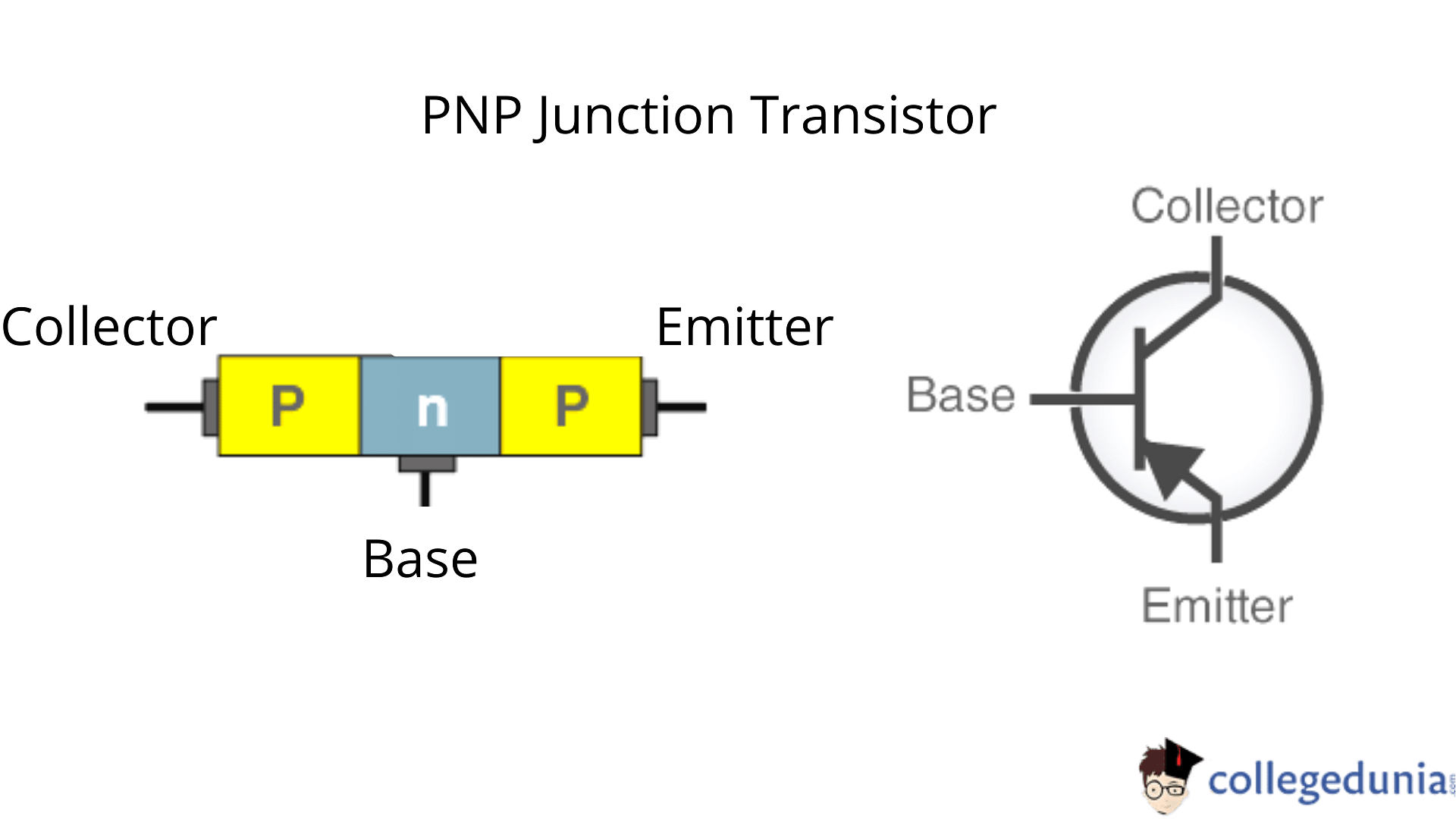
Content Strategy Manager
A bipolar junction transistor is a three-layer semiconductor device that contains 2 p-n junctions to amplify the signal. A transistor is a three-terminal device whose output current, power, and voltage are controlled by the input current. Transistors can be classified as – bipolar junction transistors and field effect transistors. Bipolar Junction Transistors (BJTs) are used for the transfer of an input signal from a lower resistance circuit to a higher resistance circuit. The transistors have three terminals with two p-n junctions used to increase the range of the signal. The BJT is used as a linear amplifier to amplify an electrical signal and also as an electronic switch.
| Table of Content |
Key Terms: Bipolar Junction Transistor, Transistors, Semiconductors, P-N Junction, Voltage, Current, Diode, Resistance, Circuit, Signal
What is Bipolar Junction Transistor?
[Click Here for Previous Year Questions]
Bipolar Junction Transistors are responsible for the transfer of an input signal from a lower resistance circuit to a higher resistance circuit.
| BJT is a transistor with three terminals with two p-n junctions used to increase the range of the signal. |
These transistors are controlled by the current. A signal of small amplitude applied to the base is available in the amplified form at the collector of the transistor. This is the amplification provided by the BJT. Bipolar Junction Transistor requires an external source of DC power supply to carry out the amplification process.

Bipolar Junction Transistor Symbol
Construction of Bipolar Junction Transistor
BJT is constructed with 3 doped regions – Base, Collector & Emitter which are separated by two p-n junctions. Bipolar transistors are manufactured as PNP and NPN transistors. They have a wide application in electronic devices such as televisions, mobile phones, radio transmitters, etc.
- A bipolar junction transistor is a current-controlled semiconductor device with three terminals having of two p-n junctions.
- The three terminals of a bipolar junction transistor (BJT) are the base, the collector, and the emitter.
- A signal of small amplitude is supplied to the base and its amplified form is then collected at the collector of the transistor.
- The amplification process of BJT requires an external source of DC power supply.
The video below explains this:
Transistor Detailed Video Explanation:
Check More:
Operation of Bipolar Junction Transistors
[Click Here for Sample Questions]
Bipolar Junction Transistor has three operating regions:
Active Region
In the active region of BJT, it acts as an amplifier.
Saturation Region
The transistor is on and operates as a switch so that the collector current is equal to the saturation current in the saturation region.
Cut-off Region
The transistor is off and the collector current is equal to zero in the cut-off region.
Types of Bipolar Junction Transistors
[Click Here for Previous Year Questions]
Bipolar Junction transistors are of two types:
PNP Bipolar Junction Transistor
In PNP Bipolar Junction Transistor, the n-type semiconductor is sandwiched between two p-type semiconductors.
- The n-type semiconductor acts as a base.
- The two p-type semiconductors in PNP BJTs act as emitter and collector respectively.
- Through the emitter, the current enters the transistor making the emitter-base junction forward biased and the collector-base junction reverse biased.

PNP Bipolar Junction Transistor
NPN Bipolar Junction Transistor
In NPN Bipolar Junction Transistor, a p-type semiconductor is sandwiched between the two n-type semiconductors.
- The p-type semiconductor acts as a base.
- The two n-type semiconductors act as emitter and collector respectively.

Function of Bipolar Junction Transistors
[Click Here for Sample Questions]
Bipolar Junction Transistors are responsible for the transfer of an input signal from a lower resistance circuit to a higher resistance circuit.
- BJT is a transistor with three terminals with two p-n junctions used to increase the range of the signal.
- Bipolar Junction Transistors have 3 doped semiconductor regions which are called base, collector and emitter and they are separated by a 2 p-n junction.
- The transistor operates as an amplifier in the active region of the Bipolar Junction Transistor.
Bipolar Junction Transistor Notes PDF Download

Applications of Bipolar Junction Transistors
[Click Here for Previous Year Questions]
Some of the applications of Bipolar Junction Transistors are –
- Bipolar Junction Transistor is used as a switch, an amplifier, switch, filter, and oscillator.
- Demodulator, also known as Detector, uses Bipolar Junction Transistor.
- Bipolar Junction Transistor is used in logic and switching circuits.
- Bipolar Junction Transistor is also used for clipping circuits so as to shape the waves.
Bipolar Junction Transistors: Voltage, Charge Control and Current
[Click Here for Sample Questions]
Collector emitter current controls the base-emitter current. Bipolar Junction Transistor can be connected with an electric circuit in three ways as Bipolar Junction Transistor has three terminals:
- Common Emitter Configuration: It has both voltage and current gain
- Common Collector Configuration: It has no voltage gain but has a current gain
- Common Base Configuration: It has no current gain but has a voltage gain
Characteristics of Bipolar Junction Transistor
The characteristics of several transistor configurations are mentioned below:
| Characteristics of Transistor Configuration | Common Emitter | Common Base | Common Collector |
|---|---|---|---|
| Power Gain | Very high | Low | Medium |
| Voltage gain | Medium | High | Low |
| Current gain | Medium | Low | High |
| Phase angle | 180 | 0 | 0 |
| Output impedance | High | Very high | Low |
| Input Impedance | medium | Low | High |
Things to Remember
- Bipolar Junction Transistor has three operating regions – Active region, Saturation Region, and Cut-off region.
- There are two types of Bipolar Junction Transistors – PNP Bipolar Junction Transistor and NPN Bipolar Junction Transistor.
- Bipolar Junction Transistor can be connected with an electric circuit in three ways.
- BJTs have three terminals: Common Emitter Configuration, common collector configuration, and common base configuration.
- BJT is mainly used to increase the range of the signal.
Read More:
Previous Year Questions
- The angular frequency of a tuned collector oscillator … [KEAM]
- The barrier potential of a p−n junction depends … [NEET 2014]
- The input signal given to a CE amplifier … [NEET 2015]
- The current I … [KEAM]
- The depletion layer of a p-n junction … [KEAM]
- The TV signals have a bandwidth of … [COMEDK UGET 2014]
- The layer in earth's atmosphere which reflects radio waves … [COMEDK UGET 2012]
- Advantages of optical fibre communications over two wire … [GUJCET 2008]
- In an amplitude modulation with modulation index … [KEAM]
- A ground receiver in line-of-sight communication … [KEAM]
- A ground receiver receives a signal at … [KEAM]
- The dominant mechanisms for motion of charge carriers in forward …
- An n−p−n transistor has three lead … [JEE Mains 2014]
- In the figure, given that VBB supply can vary from 0 to … [JEE Mains 2019]
- In n-p-n transistor, the collector current is 10 mA … [KEAM]
- For transistor action (1) Base, emitter and collector … [NEET 2010]
- For transistor action, which of the following statements is correct? … [NEET 2020]
- For CE transistor amplifier, the audio signal voltage across the collector … [NEET 2016]
- A n−p−n transistor is connected to common emitter configuration … [NEET 2016]
- An−p−n transistor conducts when … [NEET 2003]
Sample Questions
Ques. What are the two types of Bipolar Junction transistors? (1 Mark)
Ans. There are two types of Bipolar Junction Transistor and they are PNP Bipolar Junction Transistor and NPN Bipolar Junction Transistor
Ques. What is the role of PNP Bipolar Junction Transistors? (2 Marks)
Ans. In PNP Bipolar Junction Transistor, the n-type semiconductor is sandwiched between the two p-type semiconductors. The two p-type semiconductors act as emitter and collector respectively while the n-type semiconductor acts as a base.
Ques. What is the role of NPN Bipolar Junction Transistors? (2 Marks)
Ans. NPN Bipolar Junction Transistor, a p-type semiconductor is sandwiched between the two n-type semiconductors. The two n-type semiconductors act as emitter and collector respectively while the p-type semiconductor acts as a base.
Ques. Discuss the need for biasing the transistor. (3 Marks)
Ans. For normal operation, the base-emitter junction should be forward-biased, and the collector-base junction reverse-biased. The amount of bias required is significant for the establishment of the operating or the Q-point which is dictated by the mode of operation desired.
In case the transistor is not biased properly, it would :
- Work inefficiently
- Produce distortion in the output signal
- With the change in transistor parameters or temperature rise, the operating point may shift and the amplifier output will be unstable.
Ques. Name the three operating regions of the Bipolar Junction Transistor and explain their features. (3 Marks)
Ans. Bipolar Junction Transistor has three operating regions – Active region, Saturation Region and Cut-off Region.
The transistor operates as an amplifier in the active region of the Bipolar Junction Transistor. The transistor is fully on and operates as a switch such that the collector current is equal to the saturation current in the saturation region of the Bipolar Junction Transistor. The transistor is fully off and the collector current is equal to zero in the cut-off region of the Bipolar Junction Transistor.
Ques. What is the function of a Bipolar Junction Transistor? (3 Marks)
Ans. The Bipolar Junction Transistor is responsible for the transfer of an input signal from a lower resistance circuit to a higher resistance circuit. The transistor operates as an amplifier in the active region of the Bipolar Junction Transistor.
The transistor is fully on and operates as a switch such that the collector current is equal to the saturation current in the saturation region of the Bipolar Junction Transistor. The transistor is fully off and the collector current is equal to zero in the cut-off region of the Bipolar Junction Transistor.
Ques. What are the different applications of a Bipolar Junction Transistor? (3 Marks)
Ans. The different applications of a Bipolar Junction Transistor are:
- Bipolar Junction Transistor is used as a switch, an amplifier, switch, filter, and oscillator.
- Demodulator also known as detector uses Bipolar Junction Transistor.
- Bipolar Junction Transistor is used in logic and switching circuits.
- Bipolar Junction Transistor is also used for clipping circuits so as to shape the waves.
Ques. Define Current Amplification Factor for CE, CC, and CB Configuration. (4 Marks)
Ans.

For Latest Updates on Upcoming Board Exams, Click Here: https://t.me/class_10_12_board_updates
Also Read:





Comments